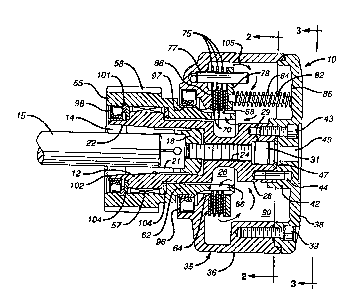Une partie des informations de ce site Web a été fournie par des sources externes. Le gouvernement du Canada n'assume aucune responsabilité concernant la précision, l'actualité ou la fiabilité des informations fournies par les sources externes. Les utilisateurs qui désirent employer cette information devraient consulter directement la source des informations. Le contenu fourni par les sources externes n'est pas assujetti aux exigences sur les langues officielles, la protection des renseignements personnels et l'accessibilité.
L'apparition de différences dans le texte et l'image des Revendications et de l'Abrégé dépend du moment auquel le document est publié. Les textes des Revendications et de l'Abrégé sont affichés :
| (12) Demande de brevet: | (11) CA 2072213 |
|---|---|
| (54) Titre français: | ACCOUPLEMENT A SURCHARGE |
| (54) Titre anglais: | TORQUE LIMITING CLUTCH |
| Statut: | Réputée abandonnée et au-delà du délai pour le rétablissement - en attente de la réponse à l’avis de communication rejetée |
| (51) Classification internationale des brevets (CIB): |
|
|---|---|
| (72) Inventeurs : |
|
| (73) Titulaires : |
|
| (71) Demandeurs : |
|
| (74) Agent: | GOWLING WLG (CANADA) LLP |
| (74) Co-agent: | |
| (45) Délivré: | |
| (22) Date de dépôt: | 1992-06-24 |
| (41) Mise à la disponibilité du public: | 1993-01-26 |
| Requête d'examen: | 1999-06-22 |
| Licence disponible: | S.O. |
| Cédé au domaine public: | S.O. |
| (25) Langue des documents déposés: | Anglais |
| Traité de coopération en matière de brevets (PCT): | Non |
|---|
| (30) Données de priorité de la demande: | ||||||
|---|---|---|---|---|---|---|
|
Docket 7435
TORQUE LIMITING CLUTCH
Abstract of the Disclosure
A hub member receives a tapered collet for gripping a drive shaft
such as a shaft projecting from an electric motor. The hub member extends
into a surrounding cylindrical housing which is secured to rotate with the
hub member and carries a set of generally square clutch plates. An
annular drive member is supported for relative rotation by the hub member
and has an inner portion projecting into the housing to support a set of
annular clutch disks which interfit between the clutch plates. The
housing encloses oil which circulates between the clutch plates and disks,
and a set of rotary seals confine the oil within the housing while
providing for rotation of the drive member relative to the hub member and
housing. The drive member has external teeth for driving a load through
an endless belt or gears, and the housing encloses a set of compression
springs which normally urge the stack of clutch plates and disks together
for transmitting a selectable maximum torque from the drive shaft to the
drive member through the hub member and housing.
Note : Les revendications sont présentées dans la langue officielle dans laquelle elles ont été soumises.
Note : Les descriptions sont présentées dans la langue officielle dans laquelle elles ont été soumises.

2024-08-01 : Dans le cadre de la transition vers les Brevets de nouvelle génération (BNG), la base de données sur les brevets canadiens (BDBC) contient désormais un Historique d'événement plus détaillé, qui reproduit le Journal des événements de notre nouvelle solution interne.
Veuillez noter que les événements débutant par « Inactive : » se réfèrent à des événements qui ne sont plus utilisés dans notre nouvelle solution interne.
Pour une meilleure compréhension de l'état de la demande ou brevet qui figure sur cette page, la rubrique Mise en garde , et les descriptions de Brevet , Historique d'événement , Taxes périodiques et Historique des paiements devraient être consultées.
| Description | Date |
|---|---|
| Inactive : CIB de MCD | 2006-03-11 |
| Demande non rétablie avant l'échéance | 2003-02-17 |
| Inactive : Morte - Taxe finale impayée | 2003-02-17 |
| Réputée abandonnée - omission de répondre à un avis sur les taxes pour le maintien en état | 2002-06-25 |
| Réputée abandonnée - les conditions pour l'octroi - jugée non conforme | 2002-02-18 |
| Un avis d'acceptation est envoyé | 2001-08-16 |
| Un avis d'acceptation est envoyé | 2001-08-16 |
| Lettre envoyée | 2001-08-16 |
| Inactive : Approuvée aux fins d'acceptation (AFA) | 2001-07-27 |
| Modification reçue - modification volontaire | 1999-12-03 |
| Inactive : Renseign. sur l'état - Complets dès date d'ent. journ. | 1999-07-05 |
| Lettre envoyée | 1999-07-05 |
| Inactive : Dem. traitée sur TS dès date d'ent. journal | 1999-07-05 |
| Exigences pour une requête d'examen - jugée conforme | 1999-06-22 |
| Toutes les exigences pour l'examen - jugée conforme | 1999-06-22 |
| Demande publiée (accessible au public) | 1993-01-26 |
| Date d'abandonnement | Raison | Date de rétablissement |
|---|---|---|
| 2002-06-25 | ||
| 2002-02-18 |
Le dernier paiement a été reçu le 2001-06-08
Avis : Si le paiement en totalité n'a pas été reçu au plus tard à la date indiquée, une taxe supplémentaire peut être imposée, soit une des taxes suivantes :
Veuillez vous référer à la page web des taxes sur les brevets de l'OPIC pour voir tous les montants actuels des taxes.
| Type de taxes | Anniversaire | Échéance | Date payée |
|---|---|---|---|
| TM (demande, 5e anniv.) - générale | 05 | 1997-06-24 | 1997-06-10 |
| TM (demande, 6e anniv.) - générale | 06 | 1998-06-24 | 1998-06-10 |
| TM (demande, 7e anniv.) - générale | 07 | 1999-06-24 | 1999-06-10 |
| Requête d'examen - générale | 1999-06-22 | ||
| TM (demande, 8e anniv.) - générale | 08 | 2000-06-26 | 2000-06-09 |
| TM (demande, 9e anniv.) - générale | 09 | 2001-06-25 | 2001-06-08 |
Les titulaires actuels et antérieures au dossier sont affichés en ordre alphabétique.
| Titulaires actuels au dossier |
|---|
| FORCE CONTROL INDUSTRIES, INC. |
| Titulaires antérieures au dossier |
|---|
| REGINALD D. KELLEY |